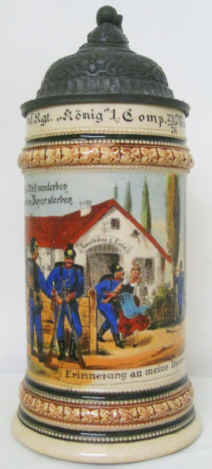
 Stein Collectors International
Stein Collectors International
Featured Stein: January 2016

 Stein Collectors International
Stein Collectors International
Featured Stein:
January 2016
 The regimental stein
originally belonging to Josef Maÿer bears the inscription The regimental stein
originally belonging to Josef Maÿer bears the inscription1. Inf. Rgt.“König” 1. Comp. 73/76 München (1st Infantry Regiment “King” 1st Company 1873-1876 Munich). This Marzi & Remy black handle stein has a well detailed Raupenhelm (caterpillar helmet) finial (see insert below), symbolic of the helmets worn by the Bavarian Army from 1801 to 1886. The thumblift is a Bavarian shield surrounded by militaria, topped off with a small Raupenhelm. Raupenhelme (plural) had “large combs of piled wool, reinforced with wicker-work,” that looked like a huge, fuzzy caterpillar, hence the name. The purpose of the wool comb was to hopefully protect soldiers from a saber strike to the head. Raupenhelme were not too popular with Bavarian infantrymen, however, as you can imagine what they must have weighed when those soldiers were out marching in the rain or snow. I suggest it was probably like marching with a caterpillar (tractor) on your head! Although this stein is dated 1873-1876, two years after the conclusion of the Franco-Prussian War, the body style indicates it was produced about 30 years later. Also, since we know the Marzi & Remy factory was founded in 1879, it is obvious Josef Maÿer had his stein back dated to his actual military service dates. On the face you see a large scene of a Bavarian infantryman wearing a Raupenhelm, flirting with a pretty Kellnerin (bar maid) carrying mugs of beer from the Gasthaus z. Ente (The Duck Tavern). Just to the left are two standing infantrymen under the phrase: Eher soll die Welt verderben als vor Durst ein Bayer sterben (Rather should the world go down before a Bavarian would die of thirst).  On the right, a bugler and some marching infantrymen can be seen wearing their Raupenhelme. Although the Imperial German Army adopted the Pickelhaube (spiked helmet) as their standard headgear in 1842, the Bavarian Army under orders from King Ludwig II, ever the traditionalist, stuck with their old Raupenhelme until 1886, the year Ludwig II unexpectedly died. Back dated Bavarian regimental steins with Raupenhelme finials are uncommon. |
||
|
|
||